#NOT zoology this time
Explore tagged Tumblr posts
Photo
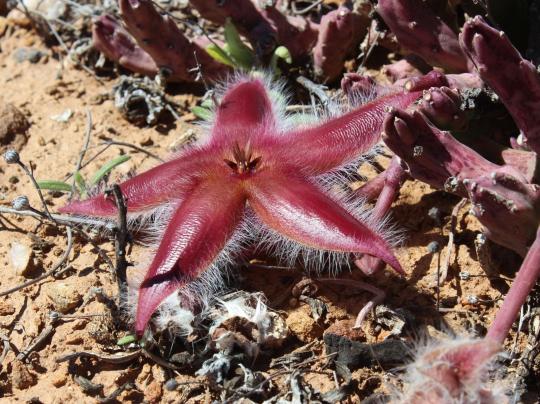
Carrion Flower (Stapelia hirsuta)
Family: Dogbane Family (Apocynaceae)
IUCN Conservation Status: Unassessed
While most flowering plants produce colourful, sweet-smelling, often nectar-secreting flowers to attract sugar-loving pollinators, the Carrion Flower and its relatives in the genus Stapelia produce hairy, “meaty-red” flowers that are said to smell like rotting flesh. The colour, hairs and smell of these flowers attract species of flies that feed or lay their eggs on carrion, and as these flies often fall for the mimicry of multiple flowers in a single blooming season they serve as pollinators, carrying pollen from male flowers to female flowers and allowing for the production of fertilized seeds, which are attached to cottony parachute-like structures that allow them to be carried away from their parent by wind. Native to western South Africa and southeastern Namibia, Carrion Flowers inhabit dry, arid habitats and are often found growing in shade cast by larger plants, which limits their access to sunlight but slows the rate at which they lose water through evaporation. Lacking well-developed leaves, members of this species respire and carry out photosynthesis using several offshoots of their stem that resemble small cacti, each with a waxy outer surface that partially blocks their stomata to further limit water loss and numerous short spines (actually what remains of their leaves) lining their edges to deter grazing herbivores such as the Cape Grysbok (a small species of antelope endemic to South Africa.) Carrion Flowers bloom in the summer and early autumn/fall, and are monoecious (meaning that every individual plant produces both pollen-producing male flowers and pollen-receiving, seed-producing female flowers.) While humans rarely harvest this species due to its unpleasant smell, it is occasionally cultivated recreationally due to its interesting biology, and the smell of its flowers have reportedly seen some use as an appetite suppressant.
--------------------------------------------------------------------------
Image Source: https://www.inaturalist.org/taxa/366290-Stapelia-hirsuta
#Carrion Flower#Stapelia#NOT zoology this time#plant#plants#wildlife#biology#botany#African wildlife#big meaty flowers
17 notes
·
View notes
Text
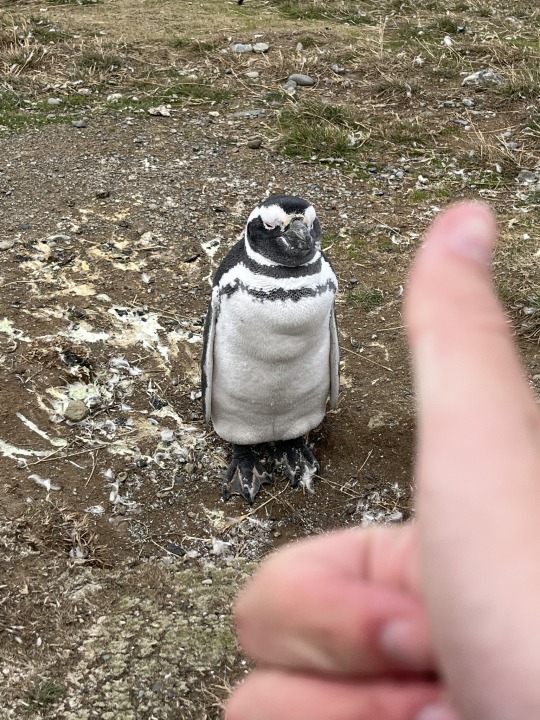
i think of this image approximately every day of my life
Magellanic Penguin (Spheniscus magellanicus) observation by kiwikiu
#inaturalist#naturalist#nature#ecology#zoology#biology#wildlife#birds#bird#birdblr#birding#orinthology#birdwatching#penguin#penguins#i cant believe this is one of masons obs and i didnt realize until now i think of this image CONSTANTLY#like every time i use the thumbs up emoji. which is a lot#thank you mason
19K notes
·
View notes
Text
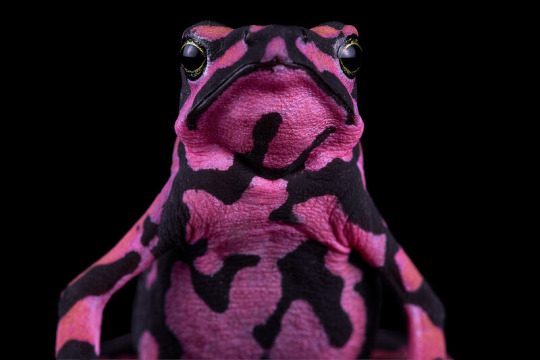
Bad Newts: Amphibians are in Serious Trouble
My colleagues and I have just had a paper published in Nature, based on our efforts to assess almost all amphibian species for the IUCN Red Lists. The major takeaway messages:
It is a bad time to be an amphibian
Two fifths of all amphibians are threatened with extinction.
Salamanders are the most threatened group; three fifths of all salamanders are threatened with extinction!
Climate change is a major driver of amphibian declines globally
Habitat loss, especially due to agriculture, is a problem for the vast majority of amphibians
Chytrid pandemics have caused and continue to cause catastrophic declines of both salamanders and frogs
Protected areas and careful management are working as strategies! They are actively improving the outlook of some species
As many as 222 amphibian species may have gone extinct in recent times; of those, 185 are suspected extinct but not yet confirmed.
Our paper is Open Access, you can read it here!
Photo of Atelopus hoogmoedi by Jaime Culebras, used with permission
#frogs#science#news#biology#zoology#newts#salamanders#amphibians#Nature#it's all over me#conservation#bad news bears#animals#this is my first Nature paper#sure I am just one of >100 authors#but I am still very excited#can you tell?#I wish I could write more about this#but I am in a grant crunch so no time#and also I have to run off to play d&d in like ten minutes#so here we are
3K notes
·
View notes
Text


fibsh…. in three dimensions....
based off yesterday's artwork
#ignore the rearmost dorsal fin clipping into the pants i wasn't bothered to find a solution to that#i still prefer 2d art but this is a really fun way to kill time#my art#splatoon#salmon run#salmonid#salmon run next wave#splatoon art#splatoon 3#speculative biology#speculative zoology#spec evo#3d model#3d art#splatoon salmon run
222 notes
·
View notes
Text

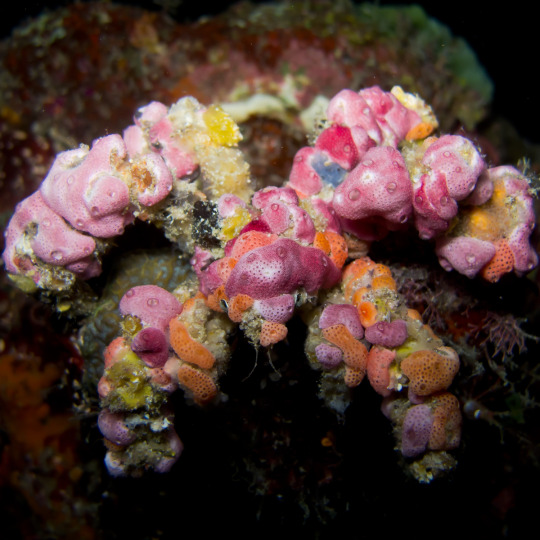
They are serving in the highest level
#decorator crab#spider crab#marine biology#aquarium#oceanposting#marine life#fishblr#crabs#time for crab#zoology#lgbtq
2K notes
·
View notes
Note
Should i be eating the green parts of strawberries ❓️❓️ probably not, but my insides are touching grass‼️‼️‼️

Click for more detail. Our ask is open!
#[We break our usual zoology kick for a normal modern!AU (aka their downtime)#but we will return to animals soon! I've got about 3 really big answers that will take a lot of time]#dungeon meshi#dunmeshi biosci au#laios touden#chilchuck tims#marcille donato#senshi#falin touden#senshi answers#dunmeshi fanart#dunmeshi
127 notes
·
View notes
Text
if youre defending one "bad" animal by telling people that oh wait this other animal is eviler and badder or generally worser actually youre doing it wrong
#'sharks are good focus on dolphins'#'dolphins are good focus on hippos'#how about simply dont#zoology#the dolphin drama turned into the sunfish drama#youd think fishblr is chill and calm but apparently not#time is a flat circle#eddie in the ocean
428 notes
·
View notes
Note
I request a parasaurolophus!
For a challenge: I request an "opposite ensthir". Like, whatever the opposite of an ensthir would be. A rihtsne if you would
If you'd like! :D

behold, my specbio pug: rihtsne...
#inviting anyone else who wants a shot at this to try pls it was fun#art#spec bio#spec evo#speculative biology#my art#speculative evolution#digital art#ensthir#speculative zoology#animal art#giggled the whole time i drew this
54 notes
·
View notes
Text
The Red and White Giant Flying Squirrel
I was scrolling on TikTok when i saw a video of an animal i have never heard of or seen before!


At first I thought that it was a possum based on the way its face looked and its size but then I saw the yellow teeth and realized it had to be a rodent. After that I narrowed in on squirrels and scoured Wikipedia to find a match.
I present to you - The Red and White Giant Flying Squirrel!

These cuties live in the forests of mainland China and Taiwan at altitudes of 800-3,500 m and 1,200-3,750 m respectively.
This specimen is often called the largest flying squirrel reaching 58 cm in length. That is without tail however, their tail exceeds their body length reaching a whopping 61.5 cm in length! Together that’s 119.5 cm! That’s bigger than the average 6 year old.
Let’s also not forget that this thing can fly, or rather, glide.

Gliding is accomplished with the help of a parachute-like membrane called a patagium. This membrane is found in all flying squirrels. Additionally it can also be found in the legs of flying frogs, the ribs of draco lizards and the fins of flying fish.
I hope to meet the Giant Red and White Flying Squirrel some day. Until then i’ll keep staring at its pictures on the internet.

#daily critter time#fun facts#red and white giant flying squirrel#silly#creature#squirrel#biology#zoology#random facts#it’s literally so beautiful help me
65 notes
·
View notes
Text

refsheet from june 2023, old art old posture, skinny legend maanuls
another refsheet for artfight execpt this one isn't finished but its enough for ppl to understand, i cant complete it due to my tablet acting crazy and that its the 20TH I NEED TO DO OTHER CHARACTERS, wish i had sooo much moretime i wanted to do more intricate patterns. one day one day ill do complicated patterns like the ones you can find on tiles from Maghreb
also, a western hat! like i mentioned western maanuls took example on the normal shell hats of eastern, this is a sneak peak of an example before i draw a sheet of them in a part 2 post about hats
#sweating yelling when i begged for AF to be soon now time moving too fast#morang#maanul#refsheet#ms paint#digital art#my art#worldbuilding#speculative zoology#artists on tumblr#oc#altuyur#2023#xenobiology#alien
787 notes
·
View notes
Text
Please support the habitat of these wonderful creatures here!

55 notes
·
View notes
Photo
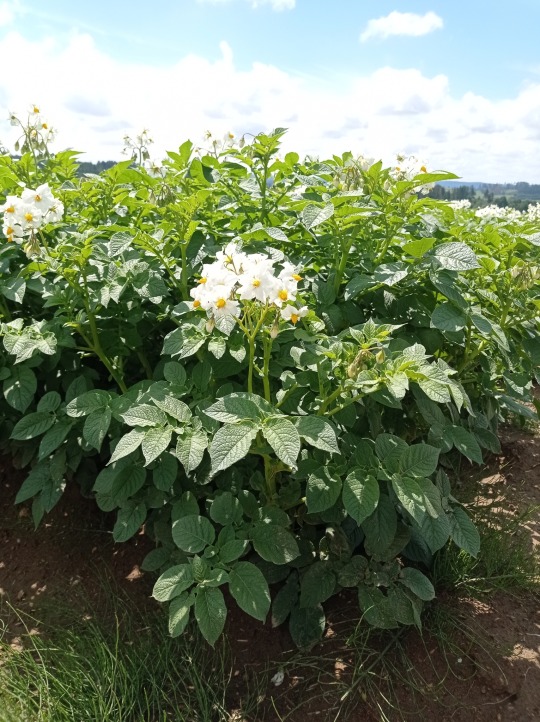
Potato Plant (Solanum tuberosum)
Family: Nightshade Family (Solanaceae)
IUCN Conservation Status: Unassessed
Originating from temperate regions of South America and southern North America, Potato Plants are now cultivated worldwide in enormous numbers (so much so that they are the 4th most important plant in achieving human food security, with over 300 million tons being produced each year.) The part of the Potato Plant that humans (as well as numerous non-human animals, including peccaries, feral pigs, rodents and deer) eat are its tubers, which are bundles of nutrients that the plant produces from offshoots of its roots during the warmer, wetter, sunnier months to sustain it throughout the winter and facilitate rapid growth during its reproductive/blooming season, which typically occurs during the mid-summer. As with many members of the nightshade family the leaves and stems of this species are poisonous, but the tubers are non-toxic when underground and only become poisonous when exposed to sunlight, with exposure to light triggering a chemical defence in which large amounts of toxic chemicals called glycoalkaloids are produced in the tuber’s skin, deterring animals that have succeeded in digging up a tuber from attempting to access other tubers and potentially damaging the roots in the process. It is because of this defensive response that uncooked potatoes may cause food poisoning if eaten in sufficient quantities – cooking denatures the glycoalkaloids and leaves the potatoes safe to eat. Potato Plants are capable of reproducing both asexually through genetically identical offshoots of their roots and sexually through the production of flowers, which range from white to purple in colour and are “perfect flowers”, meaning that a single flower is capable of both producing pollen to fertilize seeds and receiving pollen to begin developing seeds of its own. In the wild Potato Plant flowers are pollinated by small insects (particularly bumblebees), and once pollinated they develop into small fruits resembling tiny green tomatoes which are toxic to mammals but can be safely eaten by birds, allowing the seeds within them to be spread. Archaeological evidence suggests that humans have been farming Potato Plants for their tubers for some 8,000 years, with the earliest evidence of cultivation coming from what is now Peru and Bolivia.
--------------------------------------------------------------------------
Image Source: https://www.inaturalist.org/taxa/53858-Solanum-tuberosum
#Potato plant#potato#potatoes#NOT zoology this time#biology#botany#plant#plants#wildlife#south american wildlife#north american wildlife#cultivated plants
7 notes
·
View notes
Text
Daily fish fact #799
Stoplight loosejaw!

The stoplight loosejaw is able to see red with a chlorophyll derivative that absorbs red light — the fish obtains this pigment from eating copepods, which actually make up a large portion of its diet! One of its most notable features is its large, red cheek light, but it also has other lights, like a green light under the eye and several small blue lights all over its underside.
#coincidentally this fish was next on my list for fish facts to make! good timing#fish#fishfact#fish facts#fishblr#marine life#marine animals#marine biology#sea creatures#sea life#sea animals#biology#zoology#deep sea life#deep sea#deep sea fish#deep sea creatures#stoplight loosejaw#dragonfish#dead animal#dead animal tw
66 notes
·
View notes
Note
Hello, I was wondering what criteria you personally use to decide if something is a species or a subspecies?
I quite like Kevin de Queiroz's recent take on the matter, so I will refer you to him. There has been quite a bit of subsequent discussion, some of which I agree with, some of which I think is a bit moronic.
TL;DR: They should be treated as a difference of degree, not of kind, and can conveniently be used to capture the grey zone that we know characterises the incipient stages of speciation.
#speciation#taxonomy#science#zoology#biology#species#subspecies#these are real things#but genera?#genera are an illusion#families doubly so#evolution acts on populations/(sub)species#but higher taxa are just the result of what is filtered out over time#impalaparkedat221b#answers by Mark
234 notes
·
View notes
Text
illario was so right... this one traumatized crow boy really can contain such a universe of pure and childlike wonder at the mere existence -- the concept! -- of wyverns. even through the horrors
#after hearing that caterina would never let him have a wyvern dagger even when he grew up rye is definitely and for sure#buying lucanis every kind of wyvern-themed thing his little special interest heart could desire.#all while keeping hard unbroken eye contact with caterina over lucanis' shoulder#bitch I'm a speaker to the dead and the dead are savage fucking TRY me if you dare I won't hesitate#(I think the more he starts to glean about lucanis' childhood the more this is just rye's general stance with caterina at all times haha#'he loves you despite everything so I won't actively make trouble here. but the ice you're on with me is SO paper thin lady'#I think caterina has enough instinct to recognize real danger honed through a long and lethal life to heed the warning)#hearing the complete unvarnished delight in his voice when you buy him the dagger in treviso was probably rye's '...oh' moment haha#his banter about potentially using the body after a contract to bait in wyverns so he could just. look at them.#because just getting to look at them would be enough.#this guy is autistic and also a huge loss to the academic field of zoology in a different life he would have written The definitive text#about wyverns. there would be nothing left to discover after he was done he'd get it all#dragon age#dragon age: the veilguard#dragon age: the veilguard spoilers#dragon age spoilers#lucanis dellamorte
45 notes
·
View notes
Text
realized that if you ever wanted to institute an effective mass surveillance network all you'd have to do is get birders on it. they're insanely effective. whenever a notable vagrant bird(one that's extremely out of range) pops up, they have its whereabouts tracked down to the hour, god knows how
#hawk noises#bird#birds#birdblr#birding#inaturalist#naturalist#nature#ecology#zoology#biology#like that one stellars sea eagle on the east coast of the US#i dont know how they all have time for this but im frightened and intrigued#i will give birders credit on this One(1) thing
327 notes
·
View notes